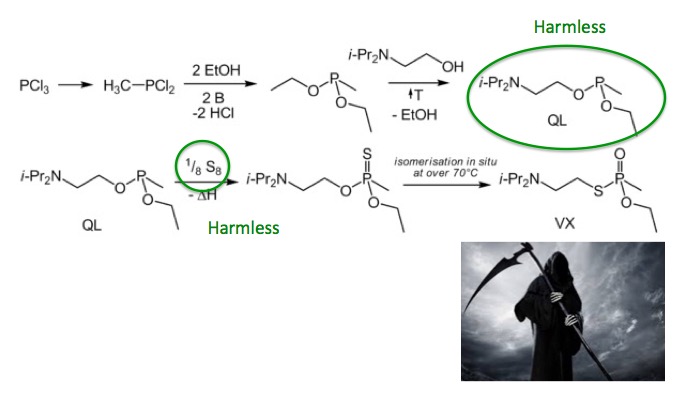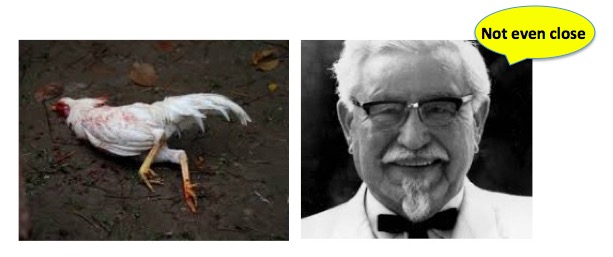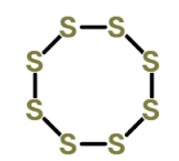
Dear Homeland Security Guys,
Despite the title, I am not suggesting that anyone reading this should actually try it. I just liked the title. And, not only is this information readily available, it's unnecessary. If any of you out there want to poison someone, just take them to Chipotle (1). (See: "Chipotle Takes The Stairway To Heavin'" and "Chipotle's Year From Hell-A-Peno."
Instead, this is a little chemistry lesson, which will: 1) discourage roughly 100 percent of even the "human-heads-in-the-freezer" guys who may be considering one of the dumbest ideas of all time, and 2) show what a profound effect a simple chemical reaction can have on toxicity.
VX is so bad that if you attempt to make it for the purpose of committing some act of malfeasance, you might want to reconsider - chances are that you will be extremely dead before you get to commit anything (2). The stuff is so toxic that it needs to be made "fresh" by combining the two chemicals required to make it. This is why VX is called a binary weapon. The two chemicals to make the poison are kept separate until "needed."

The synthesis of VX. Don't even think about it. Source: Wikipedia
For something so deadly, the two components that are combined to make it are surprisingly safe. One of them is called O-(2-diisopropylaminoethyl) O′-ethyl methylphosphonite (aka QL). QL is very close to non-toxic. When given to hens in very large doses it did... essentially nothing. The LD50 (4) of QL for a four pound hen—the median weight of a chicken that is statistically most likely (P< 0.05) to attempt to cross the road— is about 660 mg. Extrapolating this to humans (5), a lethal dose will be about 25 grams. To put this in perspective, here are a few common substances and their approximate acute lethal doses in people.
- Tylenol- 10 grams
- Aspirin- 14 grams
- Caffeine- 10 grams
So, QL is very safe. And so is sulfur, the second ingredient of VX - so much so that it is impossible to estimate a lethal dose in humans. But when you combine the two, look out. The chicken won't have the opportunity to even get to the road to ponder the age old question of whether to cross it or not.

It is the addition of sulfur that makes VX so poisonous. In a bomb, sulfur and QL are kept in separate compartments, and when detonated, the two mix and the bomb provides the heat necessary to drive the chemical reaction. Because the reaction with sulfur requires a bit of a nudge, this is probably not what was used on Kim Jong-Nam (See: VX or BS--What Really Killed Kim Jong-Nam?). Instead, there are a number of sulfur-containing liquids (damn- do they stink) that will do the job. Pouring the two together on a rag, which seems to be what happened, will do the trick.
On the other side of the chemical warfare coin is what happens when you combine two poisonous chemicals and end up with one safe one. Chlorine is a seriously deadly green gas that was used as a chemical weapon in WWI. Sodium metal is so reactive that if you put a decent sized chunk of it in your mouth, your head will soon occupy a different set of spatial coordinates than the rest of your body. But when the two are reacted, you get pure salt. Don't try that at home either.

Will Dr. Oz eat some "Magic Sodium?"
Ain't chemistry grand?
Notes:
(1) Homeland security guys aren't well known for their sense of humor.
(2) The lethal dose for VX is about 10 mg (less than a drop) on the skin, and 20-30 mg when swallowed.
(3) LD50 is the dose at which half of the experimental animals will die. The higher the LD50, the safer the chemical.
(4) If 1/8 S8 looks weird, there is a reason for it. Sulfur normally exists in a eight atom polymer. So, 1/8 S8 simply means that one atom of sulfur reacts with one molecule of QL..

S8 Source ChemSpider
(5) Extrapolation of toxicity data from animals to humans is no more than a rough guide. It is useful, but not definitive.



